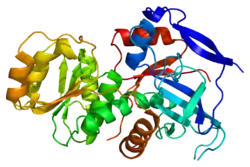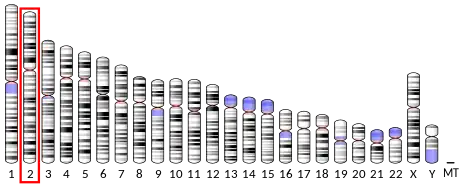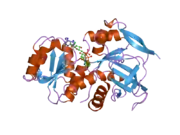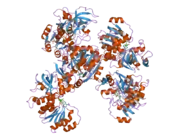TP53I3
Putative quinone oxidoreductase is an enzyme that in humans is encoded by the TP53I3 gene.[3][4][5][6]
| TP53I3 | |||||||||||||||||||||||||||||||||||||||||||||||||||
|---|---|---|---|---|---|---|---|---|---|---|---|---|---|---|---|---|---|---|---|---|---|---|---|---|---|---|---|---|---|---|---|---|---|---|---|---|---|---|---|---|---|---|---|---|---|---|---|---|---|---|---|
 | |||||||||||||||||||||||||||||||||||||||||||||||||||
| |||||||||||||||||||||||||||||||||||||||||||||||||||
| Identifiers | |||||||||||||||||||||||||||||||||||||||||||||||||||
| Aliases | TP53I3, PIG3, tumor protein p53 inducible protein 3 | ||||||||||||||||||||||||||||||||||||||||||||||||||
| External IDs | OMIM: 605171 HomoloGene: 36617 GeneCards: TP53I3 | ||||||||||||||||||||||||||||||||||||||||||||||||||
| |||||||||||||||||||||||||||||||||||||||||||||||||||
| |||||||||||||||||||||||||||||||||||||||||||||||||||
| |||||||||||||||||||||||||||||||||||||||||||||||||||
| |||||||||||||||||||||||||||||||||||||||||||||||||||
| Wikidata | |||||||||||||||||||||||||||||||||||||||||||||||||||
| |||||||||||||||||||||||||||||||||||||||||||||||||||
The protein encoded by this gene is similar to oxidoreductases, which are enzymes involved in cellular responses to oxidative stresses and irradiation. This gene is induced by the tumor suppressor p53 and is thought to be involved in p53-mediated cell death. It contains a p53 consensus binding site in its promoter region and a downstream pentanucleotide microsatellite sequence. P53 has been shown to transcriptionally activate this gene by interacting with the downstream pentanucleotide microsatellite sequence. The microsatellite is polymorphic, with a varying number of pentanucleotide repeats directly correlated with the extent of transcriptional activation by p53. It has been suggested that the microsatellite polymorphism may be associated with differential susceptibility to cancer. At least two transcript variants encoding the same protein have been found for this gene.[6]
References
- GRCh38: Ensembl release 89: ENSG00000115129 - Ensembl, May 2017
- "Human PubMed Reference:". National Center for Biotechnology Information, U.S. National Library of Medicine.
- Contente A, Dittmer A, Koch MC, Roth J, Dobbelstein M (Mar 2002). "A polymorphic microsatellite that mediates induction of PIG3 by p53". Nat Genet. 30 (3): 315–20. doi:10.1038/ng836. PMID 11919562. S2CID 19112465.
- Flatt PM, Polyak K, Tang LJ, Scatena CD, Westfall MD, Rubinstein LA, Yu J, Kinzler KW, Vogelstein B, Hill DE, Pietenpol JA (Jul 2000). "p53-dependent expression of PIG3 during proliferation, genotoxic stress, and reversible growth arrest". Cancer Lett. 156 (1): 63–72. doi:10.1016/S0304-3835(00)00441-9. PMID 10840161.
- Porte S, Valencia E, Yakovtseva EA, Borras E, Shafqat N, Debreczeny JE, Pike AC, Oppermann U, Farres J, Fita I, Pares X (Jun 2009). "Three-dimensional structure and enzymatic function of proapoptotic human p53-inducible quinone oxidoreductase PIG3". J Biol Chem. 284 (25): 17194–205. doi:10.1074/jbc.M109.001800. PMC 2719357. PMID 19349281.
- "Entrez Gene: TP53I3 tumor protein p53 inducible protein 3".
Further reading
- Maruyama K, Sugano S (1994). "Oligo-capping: a simple method to replace the cap structure of eukaryotic mRNAs with oligoribonucleotides". Gene. 138 (1–2): 171–4. doi:10.1016/0378-1119(94)90802-8. PMID 8125298.
- Polyak K, Xia Y, Zweier JL, et al. (1997). "A model for p53-induced apoptosis". Nature. 389 (6648): 300–5. Bibcode:1997Natur.389..300P. doi:10.1038/38525. PMID 9305847. S2CID 4429638.
- Suzuki Y, Yoshitomo-Nakagawa K, Maruyama K, et al. (1997). "Construction and characterization of a full length-enriched and a 5'-end-enriched cDNA library". Gene. 200 (1–2): 149–56. doi:10.1016/S0378-1119(97)00411-3. PMID 9373149.
- Strausberg RL, Feingold EA, Grouse LH, et al. (2003). "Generation and initial analysis of more than 15,000 full-length human and mouse cDNA sequences". Proc. Natl. Acad. Sci. U.S.A. 99 (26): 16899–903. Bibcode:2002PNAS...9916899M. doi:10.1073/pnas.242603899. PMC 139241. PMID 12477932.
- Nicholls CD, Shields MA, Lee PW, et al. (2004). "UV-dependent alternative splicing uncouples p53 activity and PIG3 gene function through rapid proteolytic degradation". J. Biol. Chem. 279 (23): 24171–8. doi:10.1074/jbc.M401049200. PMID 15067011.
- Gerhard DS, Wagner L, Feingold EA, et al. (2004). "The status, quality, and expansion of the NIH full-length cDNA project: the Mammalian Gene Collection (MGC)". Genome Res. 14 (10B): 2121–7. doi:10.1101/gr.2596504. PMC 528928. PMID 15489334.
- Hillier LW, Graves TA, Fulton RS, et al. (2005). "Generation and annotation of the DNA sequences of human chromosomes 2 and 4". Nature. 434 (7034): 724–31. Bibcode:2005Natur.434..724H. doi:10.1038/nature03466. PMID 15815621.
- Rohaly G, Chemnitz J, Dehde S, et al. (2005). "A novel human p53 isoform is an essential element of the ATR-intra-S phase checkpoint". Cell. 122 (1): 21–32. doi:10.1016/j.cell.2005.04.032. PMID 16009130. S2CID 2350226.
- Stelzl U, Worm U, Lalowski M, et al. (2005). "A human protein-protein interaction network: a resource for annotating the proteome". Cell. 122 (6): 957–68. doi:10.1016/j.cell.2005.08.029. hdl:11858/00-001M-0000-0010-8592-0. PMID 16169070. S2CID 8235923.




